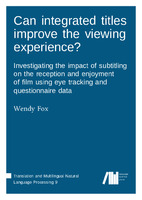Can integrated titles improve the viewing experience?
Investigating the impact of subtitling on the reception and enjoyment of film using eye tracking and questionnaire data
| dc.contributor.author | Fox, Wendy | |
| dc.date.accessioned | 2018-09-04 23:55 | |
| dc.date.accessioned | 2020-03-10 03:00:38 | |
| dc.date.accessioned | 2020-04-01T12:31:58Z | |
| dc.date.available | 2020-04-01T12:31:58Z | |
| dc.date.issued | 2018-03-02 | |
| dc.identifier | 1000384 | |
| dc.identifier | OCN: 1051775233 | en_US |
| dc.identifier.issn | 2364-8899 | |
| dc.identifier.uri | http://library.oapen.org/handle/20.500.12657/29550 | |
| dc.description.abstract | Historically a dubbing country, Germany is not well-known for subtitled productions. But while dubbing is predominant in Germany, more and more German viewers prefer original and subtitled versions of their favourite shows and films. Conventional subtitling, however, can be seen as a strong intrusion into the original image that can not only disrupt but also destroy the director’s intended shot composition and focus points. Long eye movements between focus points and subtitles decrease the viewer’s information intake, and especially German audiences, who are often not used to subtitles, seem to prefer to wait for the next subtitle instead of looking back up again. Furthermore, not only the placement, but also the overall design of conventional subtitles can disturb the image composition – for instance titles with a weak contrast, inappropriate typeface or irritating colour system. So should it not, despite the translation process, be possible to preserve both image and sound as far as possible? Especially given today’s numerous artistic and technical possibilities and the huge amount of work that goes into the visual aspects of a film, taking into account not only special effects, but also typefaces, opening credits and text-image compositions. A further development of existing subtitling guidelines would not only express respect towards the original film version but also the translator’s work. | |
| dc.language | English | |
| dc.relation.ispartofseries | Translation and Multilingual Natural Language Processing | |
| dc.subject.classification | thema EDItEUR::C Language and Linguistics::CF Linguistics | en_US |
| dc.subject.other | Linguistics | |
| dc.subject.other | Aesthetics | |
| dc.subject.other | Eye tracking | |
| dc.subject.other | Hearing loss | |
| dc.subject.other | Subtitles | |
| dc.subject.other | Typography | |
| dc.title | Can integrated titles improve the viewing experience? | |
| dc.title.alternative | Investigating the impact of subtitling on the reception and enjoyment of film using eye tracking and questionnaire data | |
| dc.type | book | |
| oapen.identifier.doi | 10.5281/zenodo.1180721 | |
| oapen.relation.isPublishedBy | 0bad921f-3055-43b9-a9f1-ea5b2d949173 | |
| oapen.relation.isFundedBy | b818ba9d-2dd9-4fd7-a364-7f305aef7ee9 | |
| oapen.relation.isbn | 9783961100651 | |
| oapen.collection | Knowledge Unlatched (KU) | |
| oapen.grant.number | 103526 | |
| oapen.grant.program | Language Science Press 2018 - 2020 | |
| oapen.remark.public | Relevant Wikipedia pages: Aesthetics - https://en.wikipedia.org/wiki/Aesthetics; Eye tracking - https://en.wikipedia.org/wiki/Eye_tracking; Hearing loss - https://en.wikipedia.org/wiki/Hearing_loss; Subtitles - https://en.wikipedia.org/wiki/Subtitles; Typography - https://en.wikipedia.org/wiki/Typography | |
| oapen.identifier.isbn | 9783961100651 | |
| grantor.number | 103526 | |
| oapen.identifier.ocn | 1051775233 |

